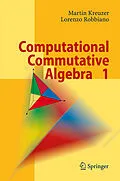This is a book about Gröbner bases and their applications. It contains 3 chapters, 20 sections, 44 tutorials, 165 exercises, and numerous further amusements.
It is going to help you bridge the gap between theoretical computer algebra and actual computation. We hope you will have as much fun reading it as the authors had writing it!
From the reviews:
"This is one of the most refreshing mathematical books I have ever held in my hands. This is academic teaching at its best; if I had not seen it, I would not have believed that it could be done so well." (Hans Stetter, IMN - Internationale Mathematische Nachrichten 2003)
"Every paragraph of the book shows how much the authors have enjoyed translating into printed matter the outcome of a long, large, deep and personal relation with computationally oriented commutative algebra. And the result is a non-standard, elementary and self-contained introduction to the theory of Gröbner bases and its applications." (Laureano González-Vega and Tomás Recio, ACM SIGSAM Bulletin 2004)
"The style of this book merits a comment. Each section begins with a quotation and an overview in which "Italian imagination overtakes German rigor". These introductions and the following main bodies of each section are well written, engaging and often amusing. The book is a pleasure to read." (John Little, Mathematical Reviews 2001)
Klappentext
This introduction to polynomial rings, Gröbner bases and applications bridges the gap in the literature between theory and actual computation. It details numerous applications, covering fields as disparate as algebraic geometry and financial markets. To aid in a full understanding of these applications, more than 40 tutorials illustrate how the theory can be used. The book also includes many exercises, both theoretical and practical.
Inhalt
Foreword Introduction 0.1 What Is This Book About? 0.2 What Is a Groebner Basis? 0.3 Who Invented This Theory? 0.4 Now, What Is This Book Really About? 0.5 What Is This Book Not About? 0.6 Are There any Applications of This Theory? 0.7 How Was This Book Written? 0.8 What Is a Tutorial? 0.9 What Is CoCoA? 0.10 And What Is This Book Good for? 0.11 Some Final Words of Wisdom Chapter 1. Foundations 1.1 Polynomial Rings Tutorial 1. Polynomial Representation I Tutorial 2. The Extended Euclidean Algorithm Tutorial 3. Finite Fields 1.2 Unique Factorization Tutorial 4. Euclidean Domains Tutorial 5. Squarefree Parts of Polynomials Tutorial 6. Berlekamps Algorithm 1.3 Monomial Ideals and Monomial Modules Tutorial 7. Cogenerators Tutorial 8. Basic Operations with Monomial Ideals and Modules 1.4 Term Orderings Tutorial 9. Monoid Orderings Represented by Matrices Tutorial 10. Classification of Term Orderings 1.5 Leading Terms Tutorial 11. Polynomial Representation II Tutorial 12. Symmetric Polynomials Tutorial 13. Newton Polytopes 1.6 The Division Algorithm Tutorial 14. Implementation of the Division Algorithm Tutorial 15. Normal Remainders 1.7 Gradings Tutorial 16. Homogeneous Polynomials Chapter 2. Grbner Bases 2.1 Special Generation Tutorial 17. Minimal Polynomials of Algebraic Numbers 2.2 Rewrite Rules Tutorial 18. Algebraic Numbers 2.3 Syzygies Tutorial 19. Computing Syzygies of Monomial Modules Tutorial 20. Lifting of Syzygies 2.4 Grbner Bases of Ideals and Modules 2.4.A Existence of Grbner Bases 2.4.B Normal Forms 2.4.C Reduced Grbner Bases Tutorial 21. Linear Algebra Tutorial 22. Reduced Grbner Bases 2.5 Buchbergers Algorithm Tutorial 23. Buchbergers Criterion Tutorial 24. Computing Some Grbner Bases Tutorial 25. Some Optimizations of Buchbergers Algorithm 2.6 Hilberts Nullstellensatz 2.6.A The Field-Theoretic Version 2.6.B The Geometric Version Tutorial 26. Graph Colourings Tutorial 27. Affine Varieties Chapter 3. First Applications 3.1 Computation of Syzygy Modules Tutorial 28. Splines Tutorial 29. Hilberts Syzygy Theorem 3.2 Elementary Operations on Modules 3.2.A Intersections 3.2.B Colon Ideals and Annihilators 3.2.C Colon Modules Tutorial 30. Computation of Intersections Tutorial 31. Computation of Colon Ideals and Colon Modules 3.3 Homomorphisms of Modules 3.3.A Kernels, Images, and Liftings of Linear Maps 3.3.B Hom-Modules Tutorial 32. Computing Kernels and Pullbacks Tutorial 33. The Depth of a Module 3.4 Elimination Tutorial 34. Elimination of Module Components Tutorial 35. Projective Spaces and Graomannians Tutorial 36. Diophantine Systems and Integer Programming 3.5 Localization and Saturation 3.5.A Localization 3.5.B Saturation Tutorial 37. Computation of Saturations Tutorial 38. Toric Ideals 3.6 Homomorphisms of Algebras Tutorial 39. Projections Tutorial 40. Grbner Bases and Invariant Theory Tutorial 41. Subalgebras of Function Fields 3.7 Systems of Polynomial Equations 3.7.A A Bound for the Number of Solutions 3.7.B Radicals of Zero-Dimensional Ideals 3.7.C Solving Systems Effectively Tutorial 42. Strange Polynomials Tutorial 43. Primary Decompositions Tutorial 44. Modern Portfolio Theory Appendix A. How to Get Started with CoCoA Appendix B. How to Program CoCoA Appendix C. A Potpourri of CoCoA Programs Appendix D. Hints for Selected Exercises Notation Bibliography Index
